-
 517 Hits
517 Hits
-
 79.78% Score
79.78% Score
-
 11 Votes
11 Votes
|
|
Mountain/Rock |
|---|---|
|
|
45.33226°N / 7.22286°E |
|
|
Piemonte |
|
|
Trad Climbing, Aid Climbing |
|
|
Summer |
|
|
5906 ft / 1800 m |
|
|
Overview
Geographical classification: Western Alps > Graie Alps > Southern Graie Alps > Sea-Monfret group > Trono di Osiride
Trono di Osiride 1800 m
The wild and uncontaminated Vallone di Sea, starting from the village of Forno Alpi Graie, the last inhabited center of the Val Grande di Lanzo in Piemonte, is about 10 km long. It has different rugged and vertical granite walls on both sides. These severe granite walls are full of cracks and have numerous climbing routes, always technical and rather difficult, also because they are parsimoniously equipped. In recent years, especially by Luca and Matteo Enrico, important works of re-equipment of historical itineraries have been undertaken as well as the opening of new routes. However, the routes are to be considered advisable only for expert climbers. Populated by ibexes, chamois and marmots, the Vallone di Sea environment has a decidedly alpine character. The walls are located at a variable altitude starting from 1500 meters m and exceeding 2500 meters with long approaches for the more distant structures.
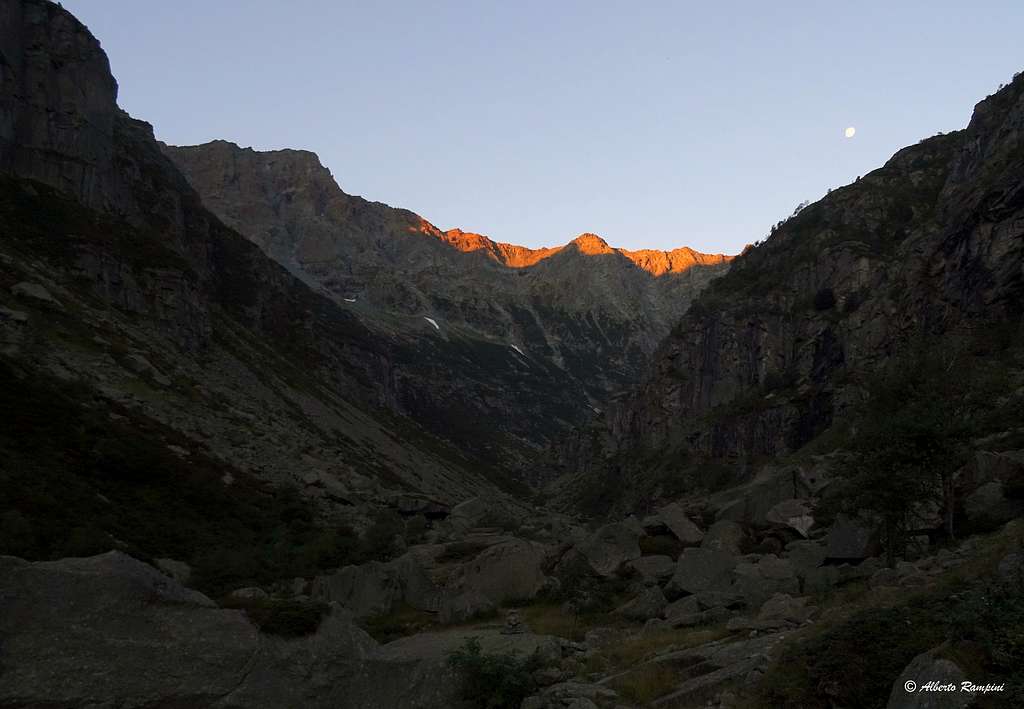
Regarding the Trono di Osiride, it is situated on the right orographic side. The original toponym of this broad and imposing rock structure is the Parete di Balma Massiet, from the name of the namesake pasture in front of the wall, later renamed Trono di Osiride due to its resemblance to a large throne with two armrests. The great wall is divided into three main sectors: the Bracciolo sinistro (left armrest), the Schienale (backrest) in the middle, where the wall reaches its maximum height (250 metres) and the Bracciolo destro (right armrest). On the left of the Bracciolo sinistro there is a fore-part called La Mummia.
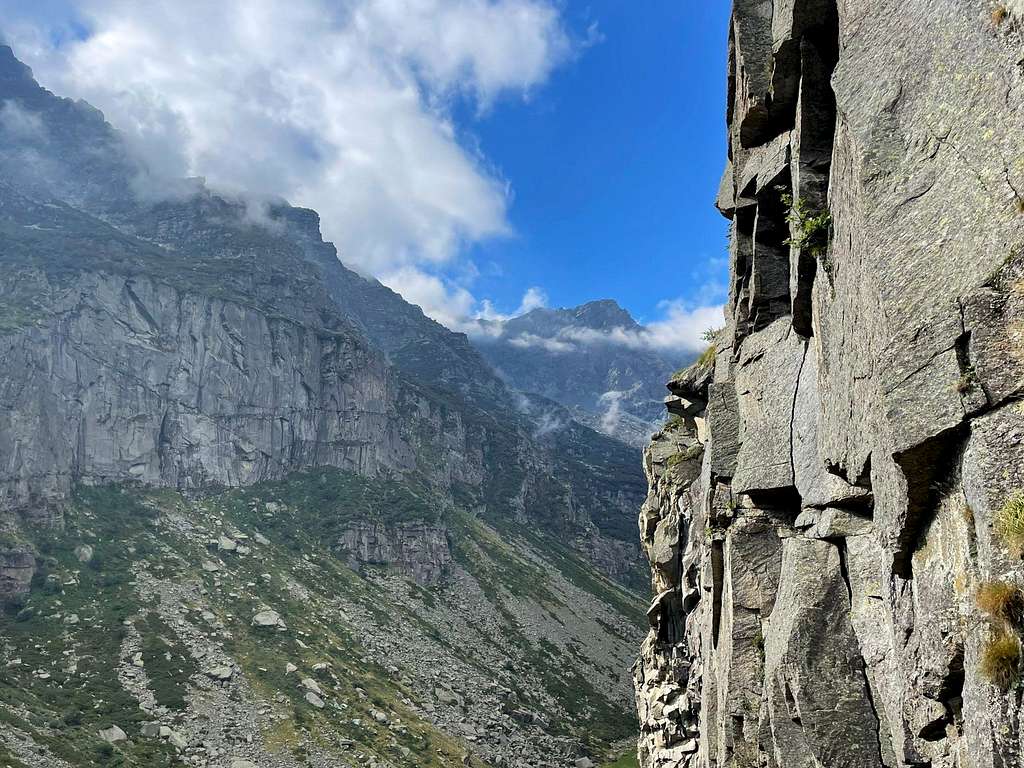
Getting There
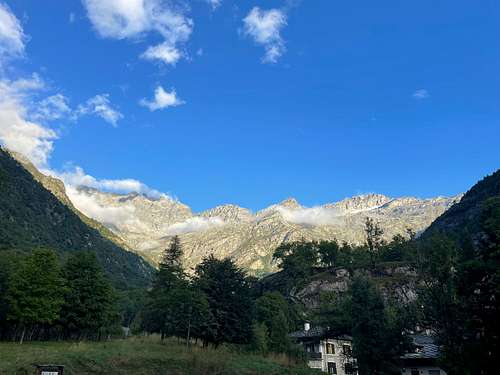
Road access
From Torino ring road take the exit Borgaro-Venaria and follow the road towards Valli di Lanzo reaching Lanzo Torinese. From here take the road entering the Valle di Lanzo and at the fork in Ceres take the right branch continuing to Cantoira, Chialamberto, Groscavallo and Forno Alpi Graie 1219 m at the head of the Val Grande di Lanzo (about 80 km from Torino). Take the left direction and park the car.
Walking approach
The approach to the various climbing routes of the Vallone di Sea follows the first part of the path to the Bivacco Soardi-Fassero all'Uja di Ciamarella.
At the end of the village of Forno Alpi Graie continue left on the dirt road that leads to the Sanctuary of Nostra Signora di Loreto and park near the junction with the Vallone di Sea (no car transit). Take the road that climbs steeply to the right and after passing some buildings of the aqueduct, reach the point where the road crosses the Stura di Sea stream.
Leave it here and continue on the path that stays on the right side (orographic left). From Forno Alpi Graie continue left on the road that leads to the Sanctuary of Nostra Signora di Loreto and park near the junction with the Vallone di Sea (no transit). Walk to the right on the dirt road and after about 10 minutes you pass the aqueduct buildings and reach the point where the road crosses the Stura di Sea stream. Leave it here and continue on the path on the right side of the valley (orographic left), then continue to the grassy plain where it stands the pasture of Balma Massiet, at an altitude of about 1500m. Cross the Stura on the bridge to get to the left side of the valley (orographic right). Then return in the direction of the valley floor along the stream. To get the start of the routes of the "Bracciolo sinistro" of the Throne it is advisable to leave out the first stony ground, which descends under the "Schienale" (central part), instead going up easily the second one you come across, when this runs out, looking for the best route among the vegetation (progression not easy). Rise up to the base of the sector (start at an altitude of about 1700m, 500m difference in height, about 1h 20').

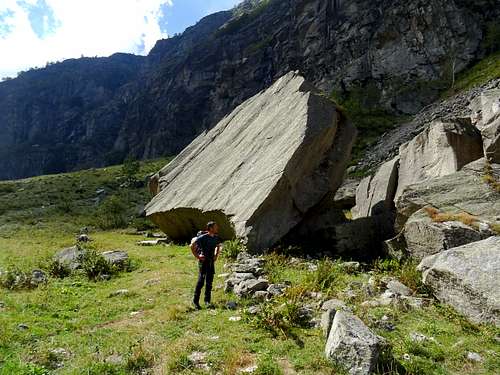
The path continues under the Costiera di Malatret and, after a short climb, continues along the valley floor up to the grassy plain where it stands the pasture of Balma Massiet at an altitude of about 1500m.
Main routes
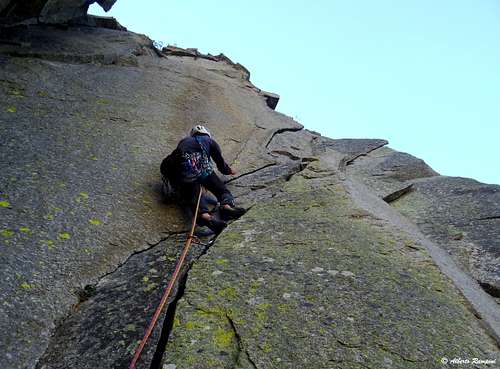
From left to right:
La Mummia
- Belfagor 7a/A0 (obbl. 6a+/A0) 100 m P. Giannattasio, G.C. Grassi, A. Morittu 1989
- Ciccio Bum 6b+ (obbl 6a+) 120 m E. Bonfanti, E. Crudo, G.C. Grassi, F. Melina , A. Morittu 1989
- La Tela di Penelope 6b+ (obbl. 6a+) 100 m. G.C. Grassi, A. Siri 1987
Bracciolo Sinistro
- Soffio di Fiaba 6c (obbl. 6a) 150 m G.C. Grassi, I. Meneghin 1982
- I misteri della fisica 6a+ (obbl. 6a) 150 m D. Caneparo, P.G. Rossetti 1983
- Urlo del Silenzio 6a+ (obbl. 6a) 150 m R. Calosso, D. Caneparo, R. Mochino, M. Oviglia 1984
- Diedro di un tempo... 7a/A1 (obbl. 6a+/A1) 140 m G.C. Grassi, S. Stohr 1989
- Fettuccia Nera 6c (obbl. 6a+) 150 m L. Enrico, M. Enrico, D. Margiotta 2016
- I misteri del ripiego 6b/A1 150 m L. Enrico, M. Enrico, D. Margiotta 2016
- Via del Ripiego 6b (obbl. 6a) 150 m I. Meneghin, A., C., M. Restagno 1981
- Oltre il giardino 6c, A0 (obbl. 6a/A1) 180 m M.T. Bolla, M. Oviglia 1984
- Tut-An-Khaminon 6b/A0 (obbl. 5c, A0) 170 m D. Caneparo, S. Chianale, P. Lenzi 1983
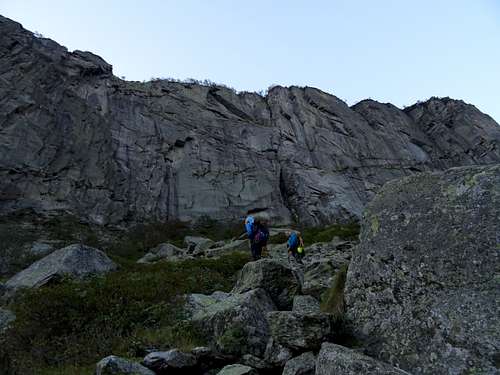
Schienale
- Molecole dal futuro A4 230 m. Isidoro Meneghin 1986
- Spade di luce 6a+, A2 200 m. G.C. Grassi, I. Meneghin 1982
- I migliori anni della nostra vita 7a+ (obbl. 6a+, A0) 250 m C. Battezzati, E. Bonfanti e Co. 2016
- Così parlò Zarathustra 7c (obbl. 6a+, A3) 170 m. D. Caneparo, I. Meneghin 1983
- Amici con le ali 7a+, NL (obbl. 6a+/A0) 230 m E. Bonfanti, C. Pajola 2019
- Serpente a sonagli 7c (obbl. 6b+, 6c) 240 m I. Ghinaudo, A. Trombetta 2001
Bracciolo Destro
- Gran Diedro d'Angolo 7a (obbl. 6a+) 200 m G.C. Grassi, M. Pettigiani 1990
- Viaggio metafisico 5c+, A2 150 m I. Meneghin, U. Manera, C. Santunione
- Droit quoi qu'il soit 6c+/A1 (obbl. 6b/A1) G.C. Grassi, E. Messina 1989
- Incastro a Mario 7a (obbl. 6b) 170 m. F. Ferrari, A. Torretta, A. Trombetta
- Docce Scozzesi 6c (obbl. 6a) 200 m I. Meneghin, S. Sibille 1978
- Massaggi Thailandesi 7a+ (obbl. 6b/A0) 200 m G.C. Grassi, S. Rossi 1988
- Mosaico di quarzo 6c+,7a (obbl. 6b) 200 m. l. e M. Enrico 2017
- Bolle di parole 6b+ (obbl. 6a+) 200 m. L. Brunati, L. Enrico, M. Enrico 2017

I misteri della Fisica route report
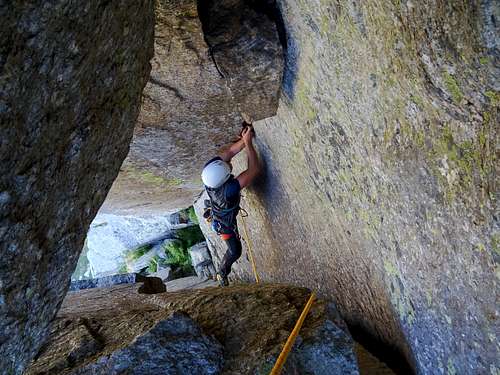
I misteri della Fisica (French scale)
Difficulty: 6a+ (obbl. 6a)
Climbing length: 150 m
Equipment: belays equipped with only 1 fix to be integrated, in place 1 fix on L5 - you need two sets of friends up to number 3, a number 4, microfriends, nuts, 60m ropes
Exposure: NW
First ascent: D. Caneparo - P. G. Rossetti 4-9-1983
Very fine route that can be climbed free, follows a system of cracks with not extreme but always very interesting climbing. The “sarcophagus” is characteristic.
L1 - Common stance with "Urlo del Silenzio". Go to the base of a large flake and go up the fine wide crack, continue on the well-held wall moving to the left, climb under a roof, go around it on the right and exit on the step where it's located the stance of "Urlo del Silenzio", V+/ 6a.
L2 - Ignore the first dihedral with cracks above the belay (via "Urlo del Silenzio") and instead climb a grassy stretch towards the dihedral on the right. Pass the flake on the right, then move towards the bottom of the dihedral, up to the large rocky wedge that forks it. Take the left branch, climb a nice finger jam crack and gain an easy rocky step, 6a+. Stop on a fix to integrate with a friend.
L3 - Ignore the dihedral on the left (via "Soffio di Fiaba") and follow the beautiful cracks above the belay which progressively oblique to the right until ending on the arête. Here, traverse to the right climbing onto a large leaning stele and enter the dihedral which ends in a niche. Here there is an old U-shaped peg (original belay). Exit the niche on the right and continue along the cracks (1 pegs) until you climb onto a small terrace, to the right of an enormous leaning stele. Belay with 1 fix to integrate with a nut and/or a friend, 6a.
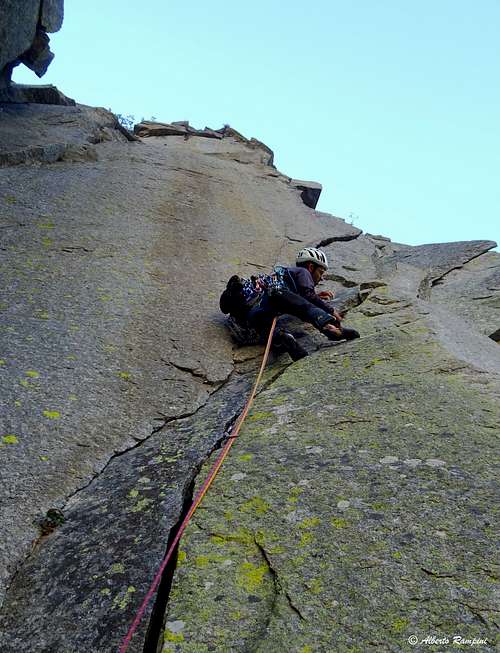
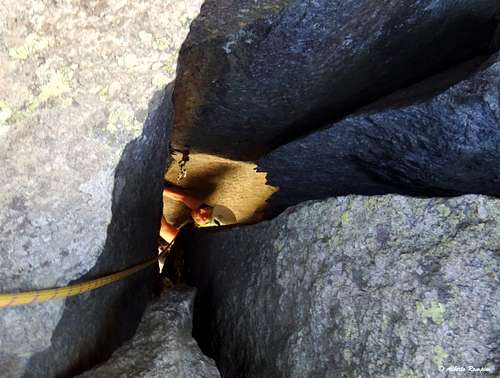
L4 - Climb straight up the well-held wall, aiming for the deep chimney (called "the sarcophagus") which is wedged into a large roof, clearly visible 30m higher more or less vertically from the stance. Once at the base of the chimney, climb the first few meters up to a flake. Stop on 1 fix plus friends, V+. Very impressive environment.
L5 - Climb the chimney until you reach the vault of the roof that closes it and exit through a hole that allows you to go back outdoors on a grassy ledge. Traverse to the left on the ledge (1 fix) up to a cracked dihedral, pass the first part and with a slightly downhill step stop in a comfortable terraced niche at the base of a large chimney. Red cord on a spike as a stop, V+.
L6 - Climb the left crack of the chimney which forms a blade inside, at the end traverse to the right (sling). Exit onto a pulpit and with a last step reach the belay terrace, 2 fix+maillon+cordone, 6a.
Descent:
Abseil down to the underlying ledge with a tree, finding the first anchor of the "Diedro di un tempo quando la storia camminava ancora lentamente". With 3 abseils get to the floor. Pay attention to the penultimate one: since the belay is a bit off the vertical it is a bit awkward to take, it is not essential but it may be better to postpone the intermediate belay not used for abseils.
Red Tape
No fees no permits required
When to Climb
The best period goes from May to October.
Accomodation
Different opportunities of accomodation in the various villages of Val Grande di Lanzo.
Meteo
Meteo Regione Piemonte
Meteo Alpi
Guidebooks and maps

"Val Grande in verticale" - Arrampicate nella Val Grande di Lanzo e nel Vallone di Sea by Marco Blatto, Elio Bonfanti, Luca Enrico, Matteo Enrico - Idea Montagna Editor

